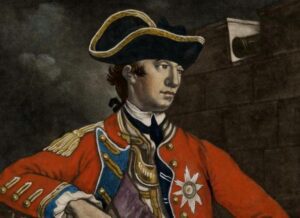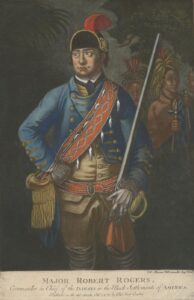
Most Americans know about the death of Nathan Hale who reportedly said before the British hanged him for espionage, “I only regret that I have but one life to lose for my country.” Hale is one of the best-known figures of the Revolution, but we know little about him, his mission, his capture, or his last words. We know he was a 21-year-old officer in the Continental Army at the time General George Washington needed information on British plans for the invasion of Manhattan. Hale volunteered to spy on the British but was soon captured and hanged. His reported last words have inspired Americans ever since.
Nathan Hale was born on 6 June 1755 in Coventry, Connecticut. He was the second son of Deacon Richard Hale and Elizabeth Stone Hale. The Hales were a prominent and devout Puritan family. They instilled in their children the importance of hard work, religious virtue, and education.
Fourteen-year-old Nathan and his older brother, Enoch entered Yale College in 1769. Nathan excelled in literature and debate and graduated with honors at the age of 18. After graduation he became a schoolteacher in East Haddan and later in New London, Connecticut.
When the Revolutionary War began in 1775, Nathan Hale joined a Connecticut militia unit, and was elected lieutenant five months later. His unit participated in the siege of Boston Massachusetts. Some accounts say Hale saw battle there, but others say he remained behind because of teaching contractual obligations.
On 4 July 1775, Hale received a letter from his Yale classmate and friend, Benjamin Tallmadge who had been in Boston during the siege. He wrote, “Was I in your condition, I think the more extensive service would be my choice. Our Holy Religion, the honor of our God, a glorious country, & a happy constitution is what we have to defend.” Several days later, Hale was commissioned first lieutenant in the 7th Connecticut Regiment which was commanded by Colonel Charles Webb.
Hale was also in Knowlton’s Rangers, the first organized American intelligence service organization, which was commanded by Lieutenant Colonel Thomas Knowlton. Nathan Hale was commissioned captain in the Continental Army in January 1776.

Following the loss of Boston in the spring of 1776, General Washington moved his army to the New York City area, which he correctly believed would be the next British target. British General William Howe recognized the strategic value of New York City and its deep-water port. In August, he began his campaign to take New York City by occupying Staten Island. From there he soundly defeated the Continental Army in the Battle of Long Island pushing Washington into Manhattan.
Washington needed to learn where Howe intended to launch an amphibious attack on Manhattan so he could deploy against it. He needed a spy behind enemy lines and called for volunteers. Captain Nathan Hale volunteered on 8 September 1776. He was the only volunteer.
Spying was not considered to be an honorable job for a “gentleman,” but Hale volunteered anyway, out of a sense of duty. He was aware of the danger because spies were summarily and quickly executed by both sides. ILR
Let’s pause here and take stock of Nathan Hale. He was obviously patriotic and well intentioned, but he was a 21-year-old man with virtually no military nor espionage training or experience. He was volunteering for a mission that he was totally unprepared for. He had no training or experience in spy “tradecraft.” He did not even know the most basic steps to avoid detection. Successful amateur spies are very rare. Most meet the same fate as Hale did.

Hale planned to pose as a Dutch schoolteacher looking for work; however, he used his real name and reportedly carried his Yale diploma bearing his real name. He was ferried from Norwalk, Connecticut across Long Island Sound to Huntington, New York on British-controlled Long Island on 12 September. However, the military situation changed quickly. Howe invaded Manhattan and forced Washington to withdraw from New York City. The British entered the city on 16 September. Hale also entered the city to spy on the British.
On 21 September, the Great New York City Fire of 1776 burned 10-25 percent of the city. The British believed Patriots had started the fire and detained 200 of them. This incident caused the British forces to be on high alert for further Patriot “sabotage.”
Nathan Hale was reportedly captured on 21 September, but who captured him and how he was captured is not known for sure. One version has him being captured while trying to cross Long Island Sound into American-held territory. Another version is that his cousin Samuel Hale who was a Loyalist, recognized him in a tavern and betrayed him.

The most accepted account was written by Consider Tiffany, a Connecticut shopkeeper and Loyalist. His family donated his papers to the Library of Congress in 2000. According to Tiffany, Major Robert Rogers of the Queen’s Rangers saw Hale in a New York City tavern and recognized him having crossed paths with him in late 1775. Rogers was a hero of the French and Indian War but was a disreputable character with a long criminal history and no loyalties. Before being commissioned in the British Army he had unsuccessfully sought a commission from General Washington.
The story goes that Rogers engaged Hale in conversation and eventually claimed to be a Patriot and a spy. Hale believed he had found a friend and told Rogers everything. Rogers then invited Hale to dine with him at his quarters the next day, and Hale accepted. Four other “Patriots” were at the dinner and a company of British soldiers surrounded the house and arrested Hale.
Hale was taken to the headquarters of General Howe who personally questioned him. Maps and drawings of fortifications were found on Hale which implicated him as a spy and Rogers provided additional information. At this point Hale gave his name, rank, and his mission. Execution orders were quickly issued.
Hale was apparently calm while awaiting execution as evidenced by the diary of British officer Frederick MacKensie: “He behaved with great composure and resolution, saying he thought it the duty of every good Officer, to obey any orders given him by his Commander-in-Chief; and desired the Spectators to be at all times prepared to meet death in whatever shape it might appear.”

Nathan Hale was marched along Post Road to the Park of Artillery, which was next to The Dove Tavern (Present day 66th Street and Third Avenue), in the morning of 22 September 1776 and hanged. In those days, hangings were performed with the victim on a wagon or cart that was pulled out from under him. Death was by strangulation and death came slowly. By all accounts Hale met his fate with composure and resolve. As the noose was placed around his neck, he made a “sensible and spirited speech” in defense of his actions and sense of duty.
Hale’s body was left hanging for several days and was later buried in an unmarked grave. His grave has never been found.
No official records were kept of Hale’s final words so debate about the accuracy of the sources has continued through the years. The quote I used is the best-known and most used. It originated with British Captain John Montresor who was at the hanging. The next day he spoke with American Captain William Hull under a flag of truce. Hull recorded in his memoirs the following words of Montresor:
“On the morning of his execution,” continued the officer, “my station was near the fatal spot, and I requested the Provost Marshall (William Cunningham) to permit the prisoner to sit in my marquee, while he was making the necessary preparations. Captain Hale entered: he was calm, and bore himself with gentle dignity, in the consciousness of rectitude and high intentions. He asked for writing materials, which I furnished him: he wrote two letters, one to his mother and one to a brother officer. He was shortly after summoned to the gallows. But a few persons were around him, yet his characteristic dying words were remembered. He said, ‘I only regret that I have but one life to lose for my country.”
Many historians have questioned the reliability of Hull’s memoirs since Hull was not present at the hanging. Many of them believe Hale spoke some variation of the best-known quote. Joseph Addison’s play “Cato” was quite popular at the time and contained the following:
How beautiful is death, when earn’d by virtue! Who would not be that youth? What pity is it that we can die but once to serve our country.
Obviously, the debate over Hale’s last words has continued. Nathan’s brother Enoch wrote in his diary after he had questioned witnesses that Nathan had given only his name and rank. The 13 February 1777 issue of the Essex Massachusetts Journal stated Hale’s last words in part: “that if he (Hale) had ten thousand lives, he would lay them all down, if called to it, in defense of his injured, bleeding country.” The Massachusetts Independent Chronicle and Universal Advertiser published this version on 17 May 1781: “I am so satisfied with the cause in which I have engaged, that my only regret is, that I have not more lives than one to offer in its service.”
All agree that Hale’s final speech was more than one sentence long, and in that speech, he stated that he regretted having only one life to give for his country. That is what is important, and the Hull version has rung “true” for over 200 years and has inspired generations of Americans. I can remember how deeply impressed I was when I first heard those words, and I am even more impressed now.
Nathan Hale was a true Patriot that was voluntarily put into a situation that he was not prepared for. His fate was sealed the day he crossed Long Island Sound into enemy territory. He made many mistakes and trusted too many people which resulted in his death. He was young, inexperienced, and naïve. His strong sense of duty and honor did not prepare him for the murky and treacherous world of espionage.
There are no known portraits of Nathan Hale. He was described by fellow soldier Lieutenant Elisha Bostwick who wrote that Hale had very fair skin, blue eyes, flaxen blond hair, darker eyebrows, was taller than the average male of the time, and had a sharp or piercing voice. He also described him as highly intelligent, athletic, and religious.
Early Americans needed heroes and Nathan Hale became one of the first. He is still an American hero that we remember and honor for his bravery and conduct when he knew he was to die. We especially remember his words when the noose was around his neck moments before the hangman carried out the sentence of death.
There are many statues of Hale. The one erected at City Hall Park, New York in1893 by Frederick William MacMonnies established the modern idealized square-jawed image. Statues of Hale are mostly found in New York and Connecticut, including at Yale College, the Hale birthplace, and the Connecticut State House. A statue of Hale also stands in the lobby of the CIA Headquarters in Langley, Virginia.

In 1846 a large stone monument was erected in honor of Nathan Hale in Coventry, Connecticut. It was one of the first war memorials to be built in the United States. This monument is in the Nathan Hale Cemetery in the South Coventry Historic District.
